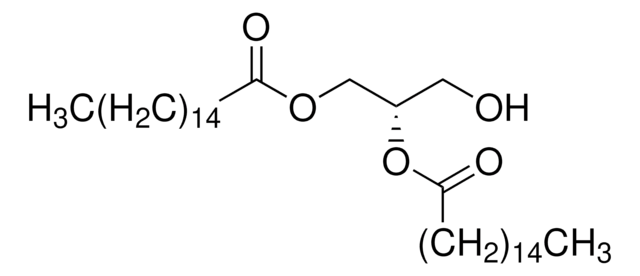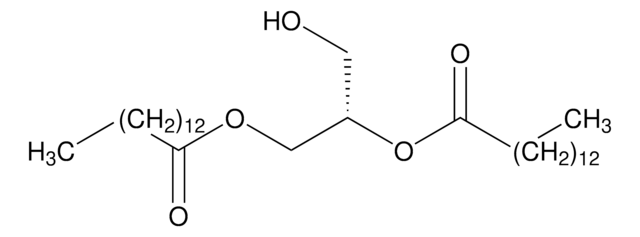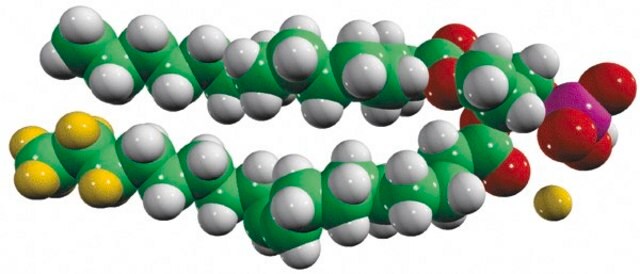800814P
Avanti
14:0 DG
1,2-dimyristoyl-sn-glycerol, powder
Sinonimo/i:
1,2-ditetradecanoyl-sn-glycerol; DG(14:0/14:0/0:0)
About This Item
Prodotti consigliati
Saggio
>99% (TLC)
Forma fisica
powder
Confezionamento
pkg of 1 × 10 mg (800814P-10mg)
pkg of 1 × 25 mg (800814P-25mg)
Produttore/marchio commerciale
Avanti Research™ - A Croda Brand 800814P
Tipo di lipide
neutral glycerides
neutral lipids
Condizioni di spedizione
dry ice
Temperatura di conservazione
−20°C
InChI
1S/C31H60O5/c1-3-5-7-9-11-13-15-17-19-21-23-25-30(33)35-28-29(27-32)36-31(34)26-24-22-20-18-16-14-12-10-8-6-4-2/h29,32H,3-28H2,1-2H3/t29-/m0/s1
JFBCSFJKETUREV-LJAQVGFWSA-N
Descrizione generale
Diacylglycerol mimicks the effects of the tumor-promoting compounds phorbol esters.
Applicazioni
- in the reconstitution of dry lipids for thin layer chromatography
- in lipid nanoparticles for RNA delivery studies
- as a standard in gas chromatography–mass spectrometry (GC-MS) analysis for the quantification of lipid A diacylglycerols
Azioni biochim/fisiol
Confezionamento
Stoccaggio e stabilità
Altre note
Dry samples of diacylglycerol in chloroform, using a stream of nitrogen. Dissolve the residue in an appropriate volume of ethanol or DMSO, then dilute to the desired aqueous medium.
Most biological responses saturate at 20 to 250 μM sn-1,2-dioctanoylglycerol. Only sn-1,2 isomers appear to be active.
Note legali
Codice della classe di stoccaggio
11 - Combustible Solids
Classe di pericolosità dell'acqua (WGK)
WGK 3
Punto d’infiammabilità (°F)
Not applicable
Punto d’infiammabilità (°C)
Not applicable
Certificati d'analisi (COA)
Cerca il Certificati d'analisi (COA) digitando il numero di lotto/batch corrispondente. I numeri di lotto o di batch sono stampati sull'etichetta dei prodotti dopo la parola ‘Lotto’ o ‘Batch’.
Possiedi già questo prodotto?
I documenti relativi ai prodotti acquistati recentemente sono disponibili nell’Archivio dei documenti.
Il team dei nostri ricercatori vanta grande esperienza in tutte le aree della ricerca quali Life Science, scienza dei materiali, sintesi chimica, cromatografia, discipline analitiche, ecc..
Contatta l'Assistenza Tecnica.
![23:2 Diyne PE [DC(8,9)PE] 1,2-bis(10,12-tricosadiynoyl)-sn-glycero-3-phosphoethanolamine, powder](/deepweb/assets/sigmaaldrich/product/images/228/422/4e95f75c-14fa-4117-a383-2eff73fa927f/640/4e95f75c-14fa-4117-a383-2eff73fa927f.jpg)






